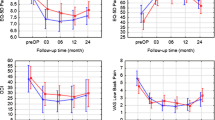Abstract
The coincidental development of minimal intervention techniques for carrying out anterior lumbar spinal fusion and the introduction of cages to provide mechanical support of introduced bone graft led to the development of a type of cage suitable for both minimal intervention use (laparoscopic) and for the standard open procedure (the BAK cage). Reported results concentrated in the main on feasibility, safety and fusion rate achieved, rather than clinical outcome. Laparoscopic insertion at the lumbosacral level was as safe as if the procedure was an open one, although there was a slighter higher incidence of retrograde ejaculation. Immediate post-operative morbidity was less with the laparoscopic procedure and discharge home and return to work was earlier. There was no long-term benefit from the laparoscopic procedure. Laparoscopic insertion at the L4/5 level was attended by a greater incidence of complications, and had a longer learning curve.
Similar content being viewed by others
Author information
Authors and Affiliations
Additional information
Received: 11 August 1999/Accepted: 26 August 1999
Rights and permissions
About this article
Cite this article
Mulholland, R. Cages: outcome and complications. E Spine J 9 (Suppl 1), S110–S113 (2000). https://doi.org/10.1007/PL00008314
Issue Date:
DOI: https://doi.org/10.1007/PL00008314




